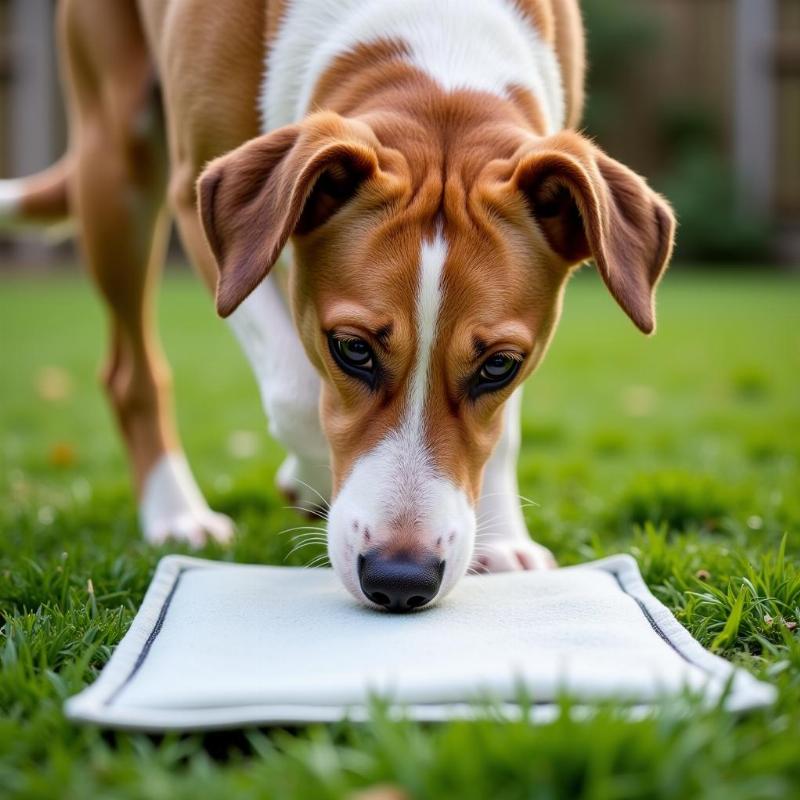House training a dog can be frustrating, especially when your furry friend refuses to use the bathroom outside. If your dog won’t go potty outside, it can be a real head-scratcher. But don’t worry, you’re not alone. Many dog owners face this challenge, and there are several reasons why it might be happening, along with effective solutions. Let’s dive into why your dog won’t use the bathroom outside and how to get them comfortably relieving themselves in the great outdoors.
Understanding Why Your Dog Won’t Potty Outside
Several factors can contribute to a dog’s reluctance to eliminate outdoors. Perhaps they’ve had a negative experience outside, associating it with fear or discomfort. Maybe they’re simply not used to the textures or smells of different surfaces like grass or concrete. Some dogs, especially puppies, might be overwhelmed by the vastness of the outdoors and feel more secure eliminating in the familiar confines of their home. Medical issues can also be a factor, so a check-up with your vet is always a good idea if the problem persists. Finally, inconsistent training or a lack of a clear routine can confuse your dog about where and when they should go potty.
Establishing a Potty Training Routine
Consistency is key to successful house training. Establish a regular schedule for taking your dog outside, including first thing in the morning, after meals, after naps, and before bedtime. Choose a designated potty spot in your yard and stick with it. This helps your dog associate that specific area with eliminating. Use a verbal cue like “Go potty” to reinforce the desired behavior.
Creating a Positive Outdoor Experience
Make going outside a positive experience for your dog. Keep the initial potty breaks short and sweet, focusing solely on the task at hand. Reward successful potty breaks with praise, treats, or a short play session. Avoid scolding or punishment if your dog has an accident indoors, as this can create negative associations with eliminating and worsen the problem. If your dog seems anxious outdoors, try taking them out on a leash to a quiet area of your yard.
Addressing Medical Concerns
If your dog suddenly stops using the bathroom outside or shows signs of discomfort while eliminating, consult your veterinarian. Urinary tract infections, bladder stones, or other medical conditions can cause changes in potty habits. A vet can diagnose and treat any underlying medical issues that might be contributing to the problem.
Troubleshooting Common Issues
Sometimes, even with a consistent routine and positive reinforcement, dogs still struggle with outdoor elimination. If your dog continues to have accidents inside, consider using enzymatic cleaners to eliminate odors that might encourage repeat offenses. If they seem reluctant to use certain surfaces, try introducing them gradually or providing a designated potty area with a surface they prefer, such as a patch of grass or a potty pad.
 Troubleshooting dog potty training issues
Troubleshooting dog potty training issues
Conclusion
Getting your dog to use the bathroom outside requires patience, consistency, and a positive approach. By understanding the potential reasons for their reluctance and implementing a structured training plan, you can help your furry friend overcome this challenge and enjoy the freedom of outdoor elimination. Remember to consult with a vet if the problem persists to rule out any medical concerns.
FAQ
-
Why is my dog suddenly refusing to potty outside? Sudden changes in potty habits can be due to several factors, including stress, changes in routine, fear, or medical issues.
-
How long does it take to house train a dog? House training timelines vary depending on the dog’s age, breed, and individual temperament. It can take anywhere from a few weeks to several months.
-
Should I punish my dog for accidents inside? No, punishment can create negative associations with eliminating and make the problem worse. Focus on positive reinforcement and consistent training.
-
What if my dog won’t pee or poop on the leash? Try taking them to a quiet, secluded area and give them ample time to relax and eliminate.
-
Can I use indoor potty pads permanently? While potty pads can be helpful during the initial stages of house training or for dogs with special needs, it’s generally recommended to transition dogs to outdoor elimination.
-
What if my dog seems scared to go outside? Make the outdoor experience positive with praise, treats, and short, enjoyable outings. Address any potential sources of fear, such as loud noises or unfamiliar environments.
-
My dog pees outside but not poop. What should I do? This can sometimes be a matter of preference. Try extending the outdoor potty breaks and offering a high-value treat immediately after they poop outside.
Related Articles
- dog suddenly barking in crate
- dog wont stop barking when i leave
- dog refuses to come inside at night
- why won't my dog go to the bathroom
- how to stop your dog from peeing on carpet
Beautdogs.us is your premier online resource for comprehensive dog care information, breed-specific guidance, and expert advice on all things dog-related in the US. Whether you’re a seasoned dog owner or just starting your journey with a new furry friend, Beautdogs.us provides trusted, engaging, and up-to-date resources to help you navigate the joys and challenges of dog ownership. From training tips and health advice to product reviews and breed insights, we’re here to support you every step of the way. Contact us for more information at [email protected] or call us at +1 501-555-7529. Visit Beautdogs.us today!